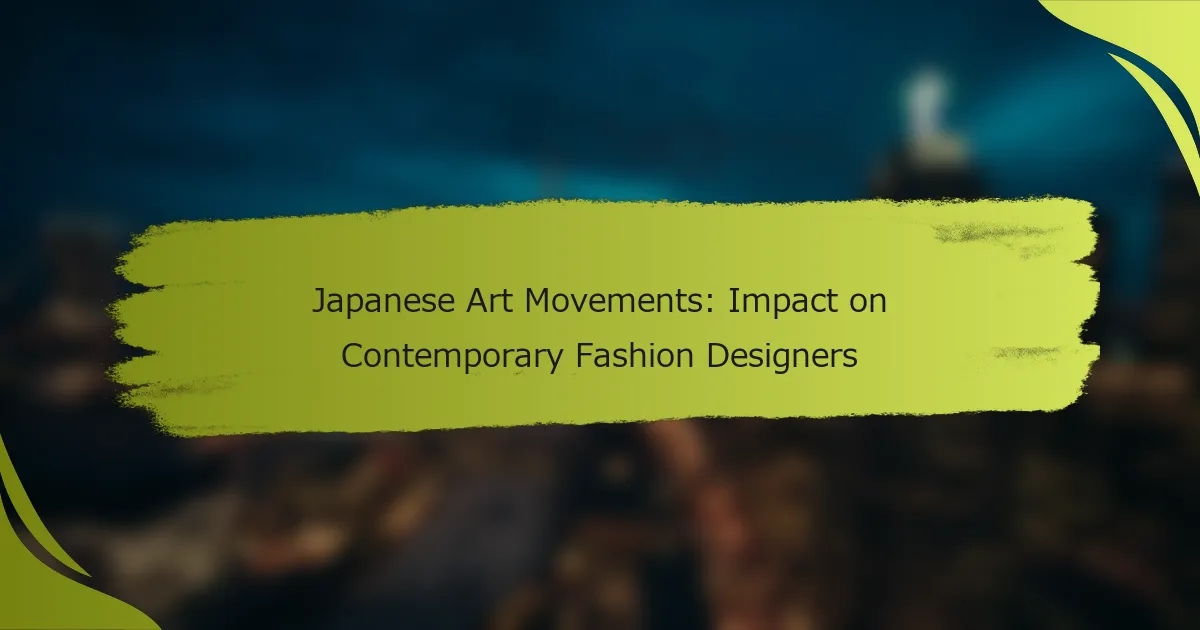Japanese art movements have profoundly influenced contemporary fashion, offering distinctive aesthetics and philosophies that resonate with modern designers. By incorporating elements from traditional techniques and concepts, designers like Issey Miyake and Yohji Yamamoto create innovative collections that reflect the rich cultural narratives of movements such as Nihonga and Superflat.
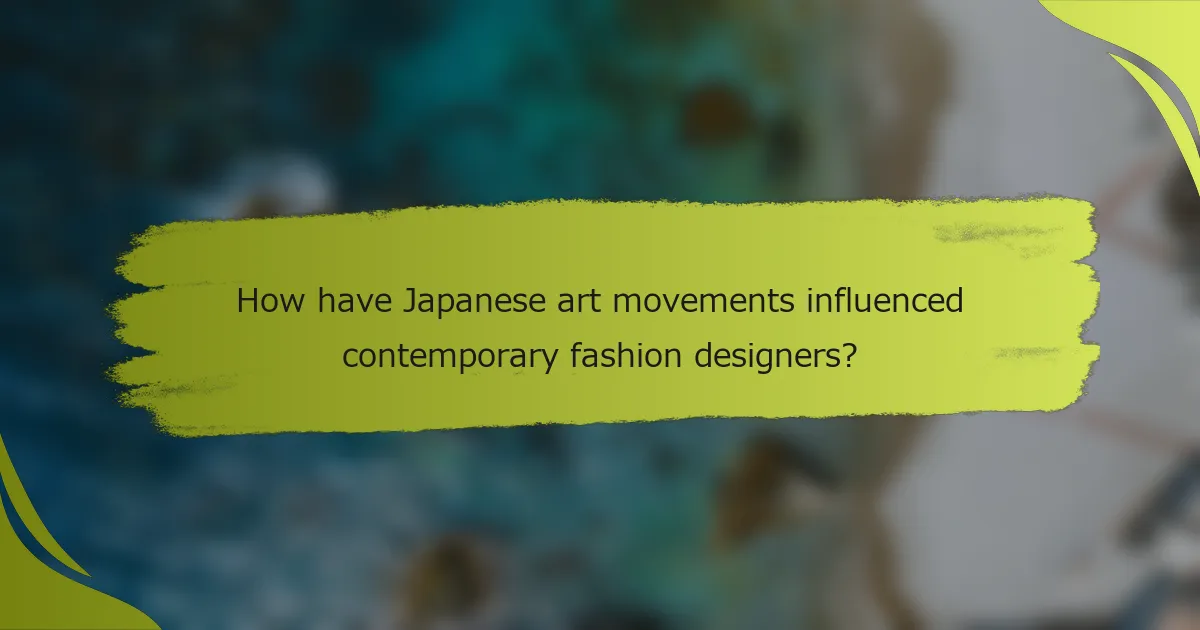
How have Japanese art movements influenced contemporary fashion designers?
Japanese art movements have significantly shaped contemporary fashion by introducing unique aesthetics and philosophies. Designers draw inspiration from traditional techniques and concepts, integrating them into modern clothing and accessories.
Impact of Ukiyo-e on modern textile design
Ukiyo-e, a genre of Japanese woodblock prints, has inspired contemporary textile design through its vivid colors and intricate patterns. Designers often replicate the flowing lines and natural themes found in Ukiyo-e, creating fabrics that evoke a sense of movement and fluidity.
For instance, brands may use large-scale floral prints reminiscent of Ukiyo-e to create eye-catching garments. This approach not only pays homage to traditional art but also appeals to consumers seeking unique and culturally rich designs.
Integration of Sumi-e techniques in fashion
Sumi-e, or Japanese ink painting, emphasizes simplicity and the beauty of brush strokes, which has been adopted by fashion designers to create minimalist yet expressive pieces. The use of Sumi-e techniques allows for a focus on craftsmanship and the art of imperfection, aligning with modern design trends that prioritize authenticity.
Fashion collections may feature garments with subtle ink-like patterns, reflecting the fluidity and spontaneity of Sumi-e. This integration encourages a dialogue between art and fashion, inviting wearers to appreciate the artistic process behind each piece.
Influence of Kintsugi philosophy on sustainable fashion
Kintsugi, the art of repairing broken pottery with gold, embodies the philosophy of embracing flaws and imperfections. This concept has influenced sustainable fashion by promoting the idea of valuing repaired or upcycled garments rather than discarding them.
Designers are increasingly creating collections that highlight mended pieces, using contrasting materials or visible stitching to celebrate the history of each item. This approach not only reduces waste but also encourages consumers to appreciate the beauty in imperfection, fostering a more sustainable mindset in fashion.

What are key Japanese art movements relevant to fashion?
Key Japanese art movements that significantly influence contemporary fashion include Nihonga and Superflat. These movements provide unique aesthetic principles and cultural narratives that designers incorporate into their collections.
Overview of Nihonga and its aesthetic principles
Nihonga, a traditional Japanese painting style, emphasizes natural materials and techniques, often using mineral pigments and washi paper. This art form is characterized by its delicate brushwork and harmonious color palettes, which reflect the beauty of nature.
In fashion, Nihonga inspires designers to focus on craftsmanship and texture, often integrating traditional motifs and patterns into modern garments. The use of natural dyes and sustainable materials is also a common practice among designers influenced by Nihonga.
Characteristics of Superflat and its fashion implications
Superflat is an art movement that blends traditional Japanese aesthetics with contemporary pop culture, characterized by flatness in visual representation and a focus on consumerism. This movement often features bold colors, graphic designs, and a playful approach to imagery.
In fashion, Superflat influences designers to create vibrant, eye-catching pieces that challenge conventional silhouettes and styles. The incorporation of anime and manga elements into clothing designs resonates with younger audiences, making fashion more accessible and relatable.
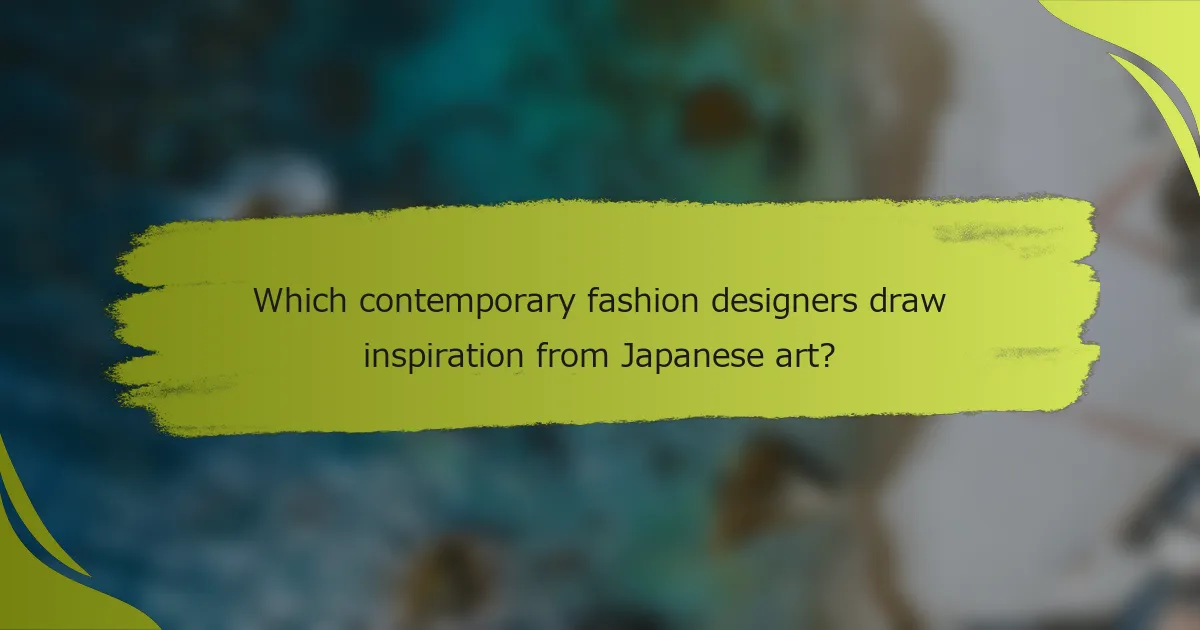
Which contemporary fashion designers draw inspiration from Japanese art?
Several contemporary fashion designers draw significant inspiration from Japanese art, integrating its aesthetics into their collections. Notable figures include Issey Miyake and Yohji Yamamoto, who both reinterpret traditional elements in innovative ways.
Issey Miyake’s use of traditional patterns
Issey Miyake is renowned for incorporating traditional Japanese patterns into his designs, often using techniques like pleating and layering. His collections frequently feature motifs inspired by kimono fabrics, which he modernizes to create functional yet artistic garments.
Miyake’s approach emphasizes the beauty of simplicity and craftsmanship, showcasing how traditional patterns can be adapted for contemporary wear. His use of vibrant colors and textures adds a fresh perspective to classic designs, making them appealing to a global audience.
Yohji Yamamoto’s reinterpretation of Japanese aesthetics
Yohji Yamamoto’s work is characterized by a deep exploration of Japanese aesthetics, particularly the concepts of wabi-sabi, which embraces imperfection and transience. His designs often feature oversized silhouettes and asymmetrical cuts, reflecting a modern take on traditional Japanese clothing.
Yamamoto skillfully blends avant-garde elements with historical references, creating pieces that challenge conventional fashion norms. This fusion not only honors Japanese heritage but also resonates with contemporary sensibilities, making his collections both timeless and innovative.
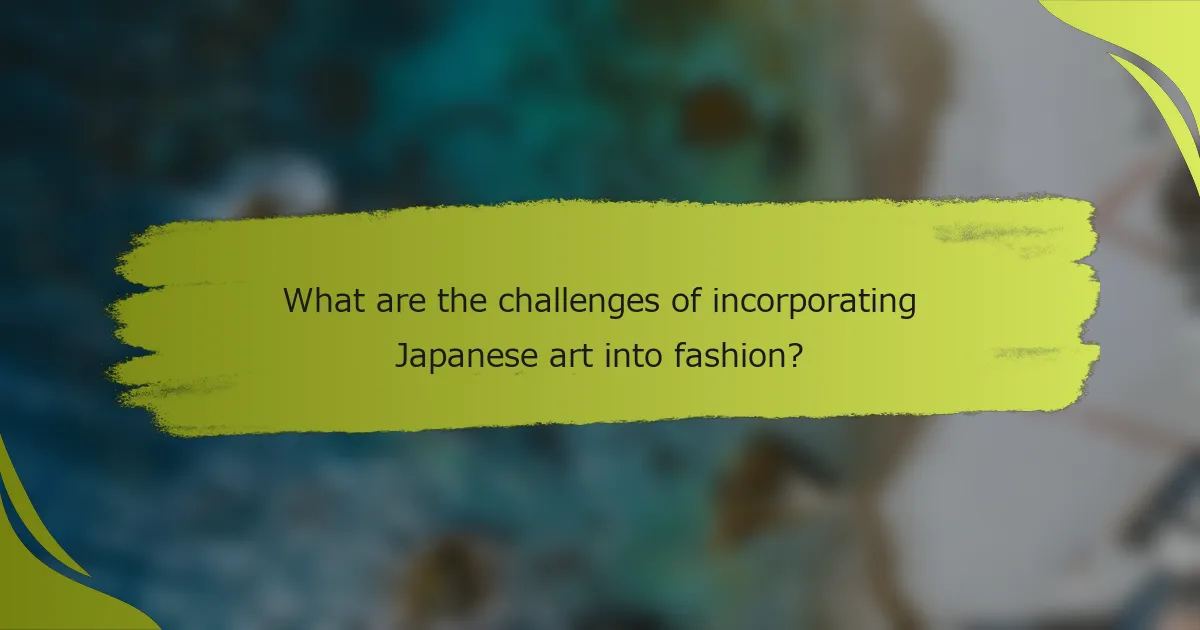
What are the challenges of incorporating Japanese art into fashion?
Incorporating Japanese art into fashion presents challenges such as cultural appropriation concerns and the need to balance traditional elements with contemporary design. Designers must navigate these complexities to create respectful and innovative pieces.
Cultural appropriation concerns
Cultural appropriation is a significant issue when integrating Japanese art into fashion. Designers must ensure they are not exploiting cultural symbols or practices without understanding their significance. This requires thorough research and often collaboration with cultural experts or artists.
To avoid appropriation, brands can focus on authentic representation and seek to include voices from the culture they are drawing inspiration from. Engaging with local artisans and incorporating their perspectives can lead to more meaningful and respectful designs.
Balancing tradition with modernity
Balancing traditional Japanese art with modern fashion trends is crucial for contemporary designers. They must find ways to honor traditional techniques and aesthetics while appealing to current consumer tastes. This often involves reinterpreting classic motifs in a way that feels fresh and relevant.
For example, using traditional patterns like Asanoha or Seigaiha in modern silhouettes can create a bridge between the past and present. Designers should experiment with materials and cuts that reflect contemporary styles while maintaining the integrity of the original art form.
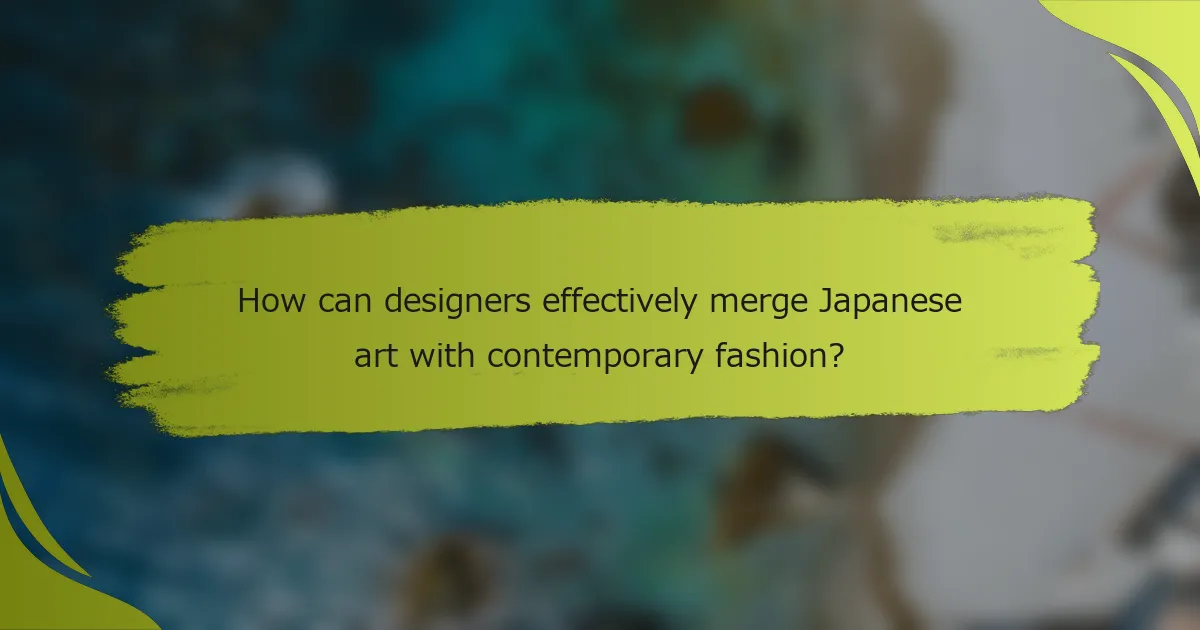
How can designers effectively merge Japanese art with contemporary fashion?
Designers can effectively merge Japanese art with contemporary fashion by embracing the aesthetic principles and cultural narratives inherent in traditional Japanese art forms. This involves a thoughtful integration of visual elements, techniques, and materials that reflect Japan’s rich artistic heritage while appealing to modern sensibilities.
Collaborative projects with Japanese artists
Collaborating with Japanese artists allows fashion designers to gain authentic insights and inspiration from traditional art forms. Such partnerships can lead to unique collections that showcase the fusion of contemporary design with classic techniques, enhancing the narrative and visual appeal of the garments.
For example, a designer might work with a calligrapher to incorporate traditional Japanese script into fabric prints, creating a dialogue between the past and present. These collaborations can also elevate brand authenticity and attract consumers interested in cultural storytelling.
Utilizing authentic materials and techniques
Using authentic materials and techniques is crucial for designers looking to honor Japanese art traditions. Fabrics such as silk, indigo-dyed cotton, and washi paper can be integrated into modern designs, offering texture and depth that resonate with Japanese craftsmanship.
Additionally, techniques like shibori (tie-dye) or sashiko (decorative stitching) can be adapted to contemporary styles, providing a unique aesthetic that stands out in the fashion market. Designers should consider sourcing materials locally to support artisans and ensure the integrity of the craft.
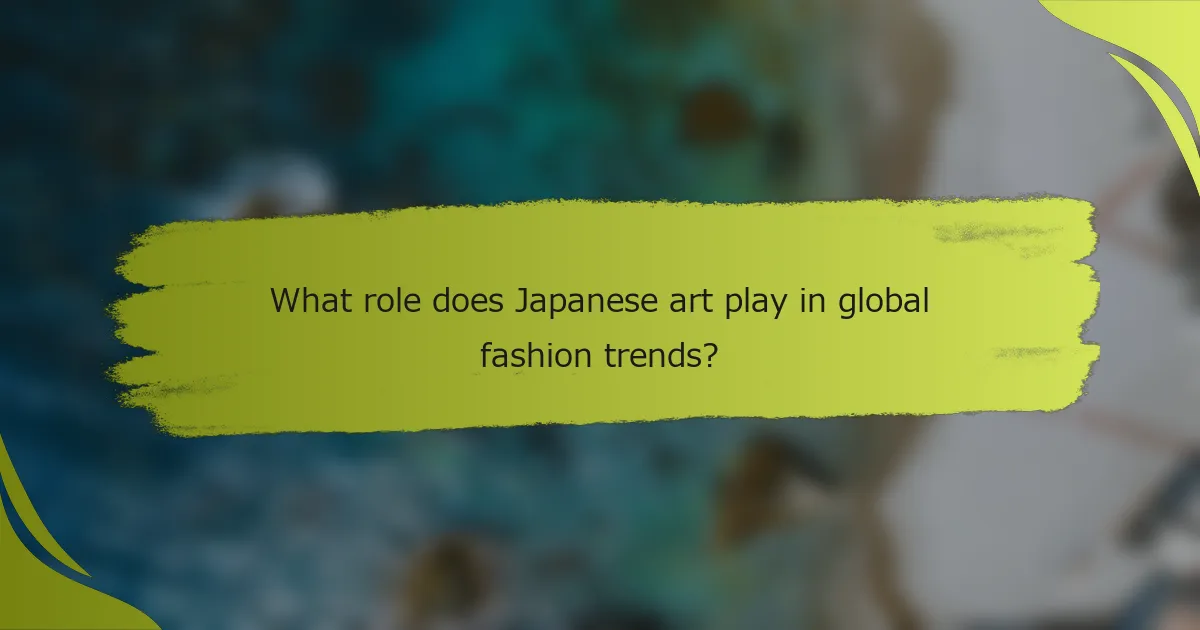
What role does Japanese art play in global fashion trends?
Japanese art significantly influences global fashion trends by introducing unique aesthetics and cultural narratives. Designers often draw inspiration from traditional techniques and motifs, blending them with contemporary styles to create innovative fashion statements.
Emerging trends in streetwear influenced by Japanese art
Streetwear has seen a surge in popularity, with Japanese art playing a crucial role in shaping its aesthetic. Elements such as bold graphics, intricate patterns, and traditional motifs are commonly incorporated into clothing, footwear, and accessories. Brands like A Bathing Ape and Comme des Garçons exemplify this trend by merging urban style with artistic influences.
Additionally, the use of techniques like shibori (tie-dye) and kanji (Japanese characters) adds depth and cultural significance to streetwear pieces. This fusion not only appeals to fashion enthusiasts but also promotes a deeper appreciation for Japanese culture among a global audience.
Global exhibitions showcasing Japanese art in fashion
Exhibitions around the world highlight the intersection of Japanese art and fashion, drawing attention to their collaborative potential. Events such as “Fashioning the Future: Japanese Fashion” at major art institutions showcase how traditional Japanese aesthetics inform modern design practices. These exhibitions often feature works from renowned designers who incorporate elements of Japanese art into their collections.
Furthermore, pop-up events and fashion weeks increasingly include Japanese designers, emphasizing their contributions to global fashion. These platforms not only celebrate the artistry involved but also encourage cross-cultural dialogue, allowing audiences to experience the richness of Japanese artistic heritage through contemporary fashion.

What are future trends in the intersection of Japanese art and fashion?
Future trends in the intersection of Japanese art and fashion will likely emphasize sustainability and the integration of digital art. Designers are increasingly inspired by traditional techniques while also exploring innovative digital mediums to create unique fashion pieces.
Increased focus on sustainability and traditional craftsmanship
The fashion industry is shifting towards sustainable practices, with Japanese designers leading the way by incorporating traditional craftsmanship. Techniques such as indigo dyeing and sashiko stitching not only preserve cultural heritage but also promote eco-friendly production methods.
Brands are now prioritizing materials that are organic or recycled, reducing waste and environmental impact. For example, using natural dyes and locally sourced fabrics can significantly lower the carbon footprint of a collection.
Potential for digital art influences in fashion design
Digital art is becoming a prominent influence in fashion design, allowing for innovative and experimental approaches. Designers are using digital tools to create intricate patterns and designs that would be difficult to achieve through traditional methods.
Collaborations between fashion designers and digital artists are on the rise, leading to collections that blend physical garments with augmented reality experiences. This fusion not only enhances visual appeal but also engages consumers in new ways, making fashion more interactive.
